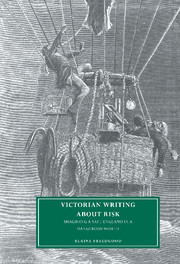Book contents
- Frontmatter
- Contents
- List of illustrations
- Acknowledgments
- Introduction: the practice of paradise
- 1 Banishing panic: J. R. McCulloch, Harriet Martineau and the popularization of political economy
- 2 The rhetoric of visible hands: Edwin Chadwick, Florence Nightingale and the popularization of sanitary reform
- 3 Groundless optimism: regression in the service of the ego, England and empire in Victorian ballooning memoirs
- 4 The uses of pain: cultural masochism and the colonization of the future in Victorian mountaineering memoirs
- 5 A field for enterprise: the memoirs of David Livingstone and Mary Kingsley
- Conclusion
- Notes
- Bibliography
- Index
- CAMBRIDGE STUDIES IN NINETEENTH-CENTURY LITERATURE AND CULTURE
3 - Groundless optimism: regression in the service of the ego, England and empire in Victorian ballooning memoirs
Published online by Cambridge University Press: 06 September 2009
- Frontmatter
- Contents
- List of illustrations
- Acknowledgments
- Introduction: the practice of paradise
- 1 Banishing panic: J. R. McCulloch, Harriet Martineau and the popularization of political economy
- 2 The rhetoric of visible hands: Edwin Chadwick, Florence Nightingale and the popularization of sanitary reform
- 3 Groundless optimism: regression in the service of the ego, England and empire in Victorian ballooning memoirs
- 4 The uses of pain: cultural masochism and the colonization of the future in Victorian mountaineering memoirs
- 5 A field for enterprise: the memoirs of David Livingstone and Mary Kingsley
- Conclusion
- Notes
- Bibliography
- Index
- CAMBRIDGE STUDIES IN NINETEENTH-CENTURY LITERATURE AND CULTURE
Summary
“The atmosphere in which we live weighs upon everyone with a twenty pound force, but do you feel it?”
Karl Marx, “Speech at the Anniversary of the People's Paper,” 1856Invented in France in 1783, balloon aerostation became immensely popular in England within months. “The chief feature of the afternoon fêtes” in the pleasure gardens from the 1830s on, a balloon ascent also marked the opening of the Crystal Palace in 1851. Although only a small number of Britons actually went up in balloons, ascents drew large audiences, and aeronautical entrepreneurs were able to charge admission to spectators and passengers alike. The balloon became a popular decorative emblem on fabrics, jewelry and china, and a diverse literature of ballooning attracted a wide readership. The balloon, however, was not solely or even originally an instrument for amusement. It evolved, or devolved, very quickly through three overlapping stages: from its original status as a major technical discovery, the precursor of navigable flight, it became an instrument for meteorological and atmospheric research, and then the Victorian equivalent of an amusement park ride.
In Wonderful Balloon Ascents (1870), Fulgence Marion ranks the discovery of balloons with the discovery of America, “equally” in that “of all other discoveries, these two have attracted the greatest amount of attention, and given, in their respective eras, the greatest impulse to popular feeling.”
- Type
- Chapter
- Information
- Victorian Writing about RiskImagining a Safe England in a Dangerous World, pp. 74 - 98Publisher: Cambridge University PressPrint publication year: 2000



